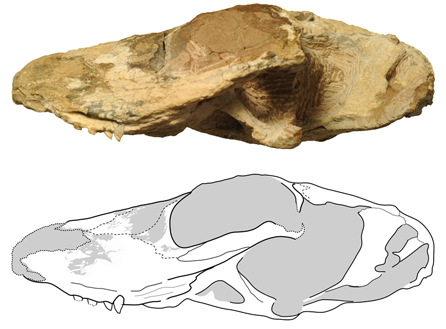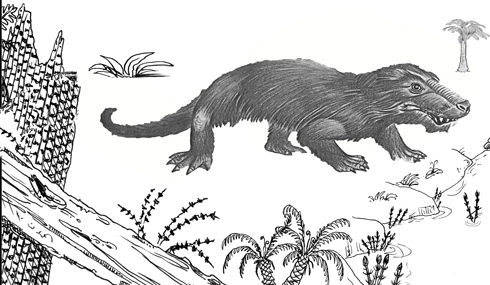Ichibengops munyamadziensis – A Nasty Little “Critter”
Researchers at the Field Museum (Chicago, Illinois) in collaboration with colleagues at the University of Utah, The Burke Museum of Natural History and Culture (Seattle) and the University of Washington have published a scientific paper detailing the discovery of a new genus of mammal-like animals that thrived prior to the Permian mass extinction event. This little synapsid is the first endemic Zambian member of the Therocephalia to be described in detail.
Late Permian Predator
The fossils, which include a partial skull and upper jaw were discovered in a field expedition back in 2009, to the Madumabisa Mudstone Formation in the Luangwa Basin (north-eastern Zambia), at the time the field team were not aware that they had discovered a new species of mammal-like reptile. A bizarre groove found on the animal’s upper jaw suggests that this little carnivore could have been venomous. Potential venom glands and tooth grooves to permit the passage of venom into wounds of prey that had been bitten, have been proposed for some other members of the Therocephalia before, but this interpretation of the fossil evidence remains controversial.
A Picture of the Holotype Skull and Jaw Material (Ichibengops munyamadziensis)
Picture credit: Adam Huttenlocker
Ichibengops munyamadziensis
Described as a “little critter” by Everything Dinosaur team members, the fossils are believed to be around 255 million years old (Wuchiapingian faunal stage of Permian). Ichibengops, (pronounced itc-chee-ben-gops) comes from the local Bemba dialect for scar and the Greek suffix for face, hence this “little critter” has been nick-named “scarface”.
A paper on the 2009 discovery has just been published in the academic publication the “Journal of Vertebrate Palaeontology”. The Therocephalia, believed to be closely related to the cynodonts are referred to as “beast heads”, on account of their robust skulls. As a group, they survived the End Permian extinction, but were greatly reduced with only a few Families persisting into the Early Triassic. This group died out at around the time of the very first dinosaurs, but it is unlikely that the rise of the Dinosauria had anything to do with the extinction of the Therocephalia.
Permian Predator
Commenting on the research, one of the authors of the scientific paper, Dr Kenneth Angielczyk (Field Museum) stated:
“Discoveries of new species of animals like Ichibengops are particularly exciting because they help us to better understand the group of animals that gave rise to mammals. One interesting feature about this species in particular is the presence of grooves above its teeth, which may have been used to transmit venom.”
Venomous?
Being venomous is rare in today’s Mammalia, only a few extant species produce venom. For example, the duck-billed platypus (Ornithorhynchus anatinus) a monotreme, is now known to be venomous as are a number of species of shrews. If this little animal was able to deliver a debilitating bite then this might have proved advantageous, helping to despatch victims quickly as well as providing a formidable defence against attack from larger predators.
An Illustration of Ichibengops munyamadziensis
Picture credit: Everything Dinosaur
Everything Dinosaur stocks an extensive range of models of animal that lived during the Palaeozoic. The CollectA range for example, includes models of many Permian animals including Dimetrodon, Edaphosaurus and Estemmenosuchus.
To view the Collect Deluxe range: CollectA Deluxe Prehistoric Life Figures.







